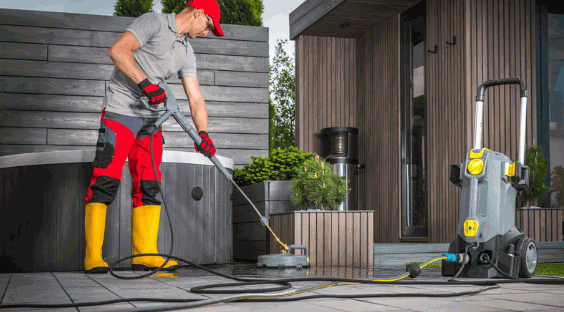Table of Contents
Pressure washing is a powerful cleaning technique that can rejuvenate your patio surfaces.
It removes dirt and grime, prevents damage, and offers a range of benefits.
But what exactly is pressure washing, and why is it used?
We will explore the different surfaces that can be pressure washed, the equipment needed, and step-by-step instructions on how to pressure wash your patio safely.
We will also discuss when it’s best to hire a professional for your pressure washing needs.
So, should you pressure wash your patio? Keep reading to find out!
Explore further: How To Clean Window Blinds
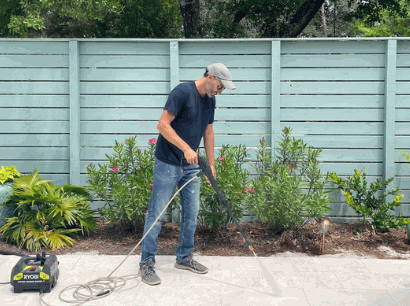
What Is Pressure Washing?
Pressure washing is a cleaning method that uses a high-pressure water spray to remove dirt, grime, stains, and other substances from surfaces. It is a powerful technique often employed for outdoor cleaning tasks.
Pressure washing is not only effective in removing common dirt and grime but has also proven to be highly efficient in tackling more stubborn stains like mould, mildew, and grease. The sheer force of the water stream can easily break down and wash away these stubborn substances. This method is not limited to just cleaning surfaces; it can also help prevent surface damage that might occur due to accumulated dirt and debris over time. By regularly using appropriate cleaning products and adjusting the pressure levels, pressure washing can rejuvenate various surfaces, from concrete driveways to wooden decks, giving them a fresh and pristine look.
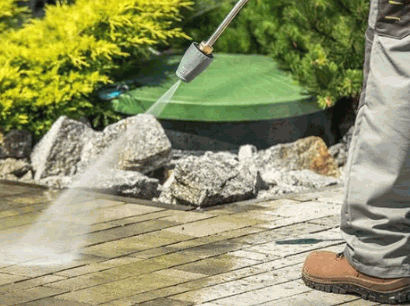
Why Is Pressure Washing Used?
Pressure washing is used for its ability to efficiently remove dirt, grime, and stains, and prevent surface damage. It is a preferred method for maintaining outdoor surfaces like patios and driveways.
Regarding cleaning and preserving outdoor areas, utilising the power of pressure washing can make a remarkable difference. The high-pressure water stream not only removes stubborn dirt and stains but also helps in preventing the accumulation of mould and mildew, which can deteriorate the sealant and overall quality of the surface.
Whether you have a brick, concrete, or wooden patio material, regular pressure washing can extend its lifespan and maintain its aesthetic appeal. By avoiding common cleaning mistakes such as using incorrect pressure levels or neglecting proper techniques, you can ensure that your outdoor surfaces remain in top-notch condition for years to come.
To Remove Dirt And Grime
Pressure washing is primarily used to remove accumulated dirt, grime, and debris from various surfaces, including patios and driveways.
Effectively combining the high-pressure water spray with specialised cleaning products can further enhance the cleaning outcomes, ensuring a thorough removal of tough stains and stubborn residues.
When performing patio cleaning, it is essential to pay attention to proper debris removal techniques. Using a push broom or leaf blower can help dislodge and gather leaves, twigs, and other debris before pressure washing to prevent clogging the equipment or spreading dirt around.
To Remove Stains
Utilising a jet wash pressure washing can penetrate deep into porous surfaces like concrete, brick, or wood, effectively dislodging embedded grime and dirt. One of the significant advantages of pressure washing is its ability to tackle challenging stains that normal cleaning methods struggle to remove.
- For oil-based stains, pre-treating the area with a degreaser before pressure washing can enhance the cleaning process.
- When dealing with mould or mildew, adding a mildewcide solution to the water tank of the pressure washer can aid in thorough removal.
Using different nozzle tips on the pressure washer allows for adjusting the pressure level according to the specific surface and stain type, ensuring optimal results without causing damage.
To Prevent Damage
Pressure washing helps prevent surface damage by removing build-up that can lead to deterioration over time, making it an essential aspect of patio maintenance.
Regular pressure washing not only enhances the aesthetic appeal of your patio but also plays a pivotal role in prolonging the lifespan of the surfaces. By eliminating dirt, grime, mould, and other contaminants, pressure washing helps prevent irreversible damage that could result from neglecting upkeep. Incorporating a routine pressure washing schedule can assist in maintaining the structural integrity of the patio, saving you from costly repairs down the line. It’s crucial to remember that investing in preventive measures like patio cleaning mistakes to safeguard surface integrity is significantly more cost-effective than dealing with extensive damage in the future.
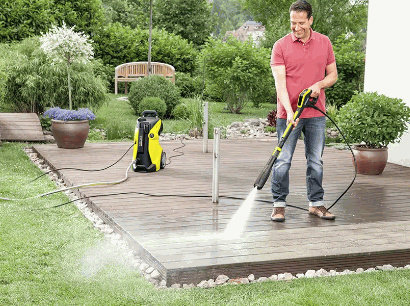
What Surfaces Can Be Pressure Washed?
Pressure washing can be used on various surfaces, including concrete, brick, wood, and stone patios, to effectively clean and maintain their appearance.
Concrete surfaces, such as driveways and walkways, are sturdy enough to withstand higher pressure levels during washing. Delicate wood surfaces, like decks and fences, require a more gentle approach to prevent damage.
Brick patios are a popular choice but can be prone to moss and mildew buildup, making pressure washing an ideal solution. For stone surfaces, it’s essential to adjust the pressure based on the type of stone to avoid erosion or pitting. Expert advice recommends starting with lower-pressure settings and gradually increasing them as needed to protect your patio furniture and other outdoor items.
Concrete Patios
Concrete patios are ideal for pressure washing due to their durable nature, but care must be taken to avoid pressure washer damage that can harm the patio surface.
Pressure-washing concrete patios offer numerous advantages beyond just aesthetics. By using high-pressure water streams, effectively removes stubborn stains, mould, mildew, and dirt buildup that can accumulate over time. This process not only enhances the overall appearance of the patio but also helps in maintaining its longevity.
It’s important to be cautious when using pressure washers on concrete surfaces. Excessive pressure settings or using the wrong patio cleaning tools can lead to irreversible damage such as chipping, cracks, or etching. To prevent such risks, it’s recommended to adjust the pressure settings according to the specific needs of the patio surface.
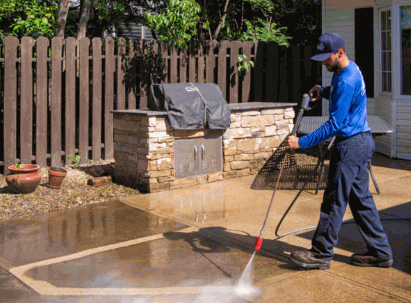
Brick Patios
Paved patios require specific cleaning methods to avoid surface damage during pressure washing, ensuring a thorough cleaning without compromising the patio’s integrity.
- When pressure washing a paved patio, it’s crucial to use the right equipment and techniques to achieve optimal results.
- Begin by selecting a suitable patio cleaning solution that is safe for brick surfaces.
- Ensure that the pressure washer is set at the appropriate level to avoid excessive force, which can lead to cracks or pitting on the bricks.
- Pay attention to the spray pattern and distance to prevent unnecessary erosion of the mortar joints.
After cleaning, it’s essential to rinse the patio thoroughly to remove any residue from the cleaning solution. Consider applying a sealant to protect the bricks and enhance their longevity. Regular maintenance, such as sweeping and gentle washing with a hose, can help prevent the buildup of dirt and grime, prolonging the life of your paved patio.
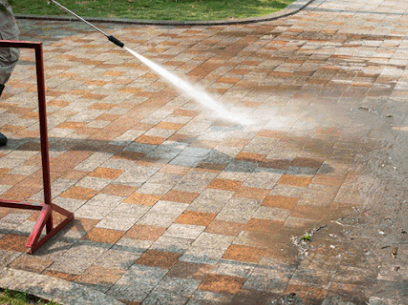
Wood Patios
Wood patios require specialised care during pressure washing to prevent damage, making it essential to seek advice from a patio cleaning expert before proceeding with cleaning.
Pressure washing wood patios can be a tricky task due to the delicate nature of the wood surface. Without proper guidance, the high pressure from the water jet can lead to splintering or gouging of the wood, compromising both the aesthetics and structural integrity of the patio.
Experts often recommend a gentle approach that involves using lower pressure settings, broader nozzles, and keeping a safe distance from the surface to prevent any accidental damage. The type of wood and its condition should be taken into consideration before starting the cleaning process.
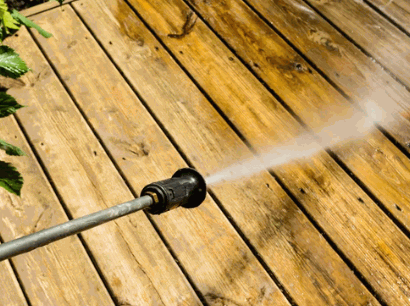
Stone Patios
Stone patios present unique challenges for pressure washing due to their porous nature, requiring adherence to specific guidelines and best practices to ensure effective cleaning and maintenance.
When pressure washing a stone patio, it’s crucial to consider the type of stone used, as different stones have varying levels of hardness and susceptibility to damage. Preserving the integrity of the stone surfaces involves using the appropriate pressure setting and nozzle attachments to avoid causing any etching or erosion.
Applying a protective sealant after pressure washing can help prevent staining and deterioration, prolonging the lifespan of the patio and enhancing its appearance. Regular maintenance tasks such as sweeping debris and addressing stains promptly are essential for maintaining the beauty and functionality of the patio.
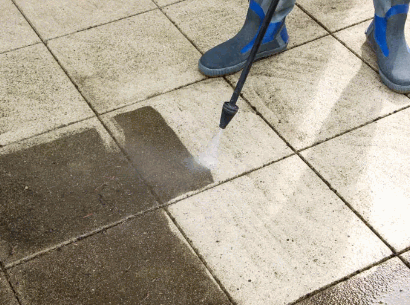
What Equipment Is Needed For Pressure Washing?
Essential equipment for pressure washing includes a pressure washer, cleaning solution, and protective gear to ensure safe and effective cleaning of various surfaces.
When selecting a pressure washer for your patio cleaning tasks, consider the pressure range, water flow rate, and whether it’s electric or petrol-powered. Petrol-powered washers offer more power for tough stains, while electric ones are easier to manoeuvre and environmentally friendly.
Using the right cleaning solution is crucial. For brick or concrete patios, opt for a degreaser or mild bleach solution. Wooden decks require a gentle cleaner to avoid damage. Always test the solution in a small, inconspicuous area first.
Don’t forget about protective gear! Eye protection, gloves, and closed-toe shoes are essential to prevent injuries from splashing water, chemicals, or debris during the patio cleaning process.
Pressure Washer
The pressure washer is the core tool for effective cleaning, with different models suitable for various patio materials and cleaning products to enhance the cleaning process.
Regarding selecting the right pressure washer for your patio, you need to consider factors such as pressure levels, nozzle types, and water flow rates. For instance, a higher pressure setting may work well for concrete but could damage more delicate surfaces like wood. Choosing the appropriate cleaning products is equally crucial in achieving optimal results. For instance, for removing tough stains on concrete, using a specialised concrete cleaner can make a significant difference.
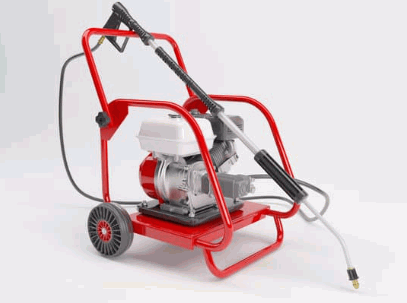
Cleaning Solution
Choosing the correct cleaning solution is crucial for effective debris removal and maintaining the patio’s sealant, ensuring a thorough and long-lasting cleaning outcome.
Regarding tackling debris on your patio, using an appropriate cleaning solution can make all the difference. Harsh chemicals may strip away the sealant, leading to potential damage in the long run. Opting for gentle yet effective products tailored for outdoor surfaces helps preserve the integrity of the sealant while effectively removing dirt and grime.
For those looking to make environmentally-conscious choices, selecting eco-friendly cleaning solutions ensures not only a clean patio but also contributes to sustainable outdoor cleaning practices. Look for biodegradable formulas that are gentle on the environment without compromising on cleaning power.
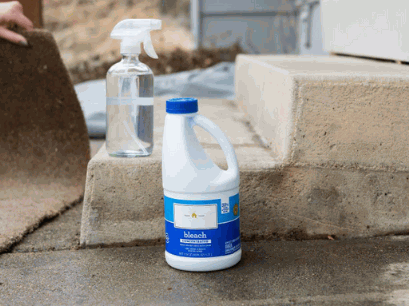
Protective Gear
Wearing appropriate protective gear such as gloves, goggles, and boots is essential to prevent injuries and safeguard against potential surface damage during pressure washing activities.
Without the right protective gear, one’s skin can be exposed to harsh chemicals in cleaning solutions, leading to irritation or burns. Failure to wear goggles can put the eyes at risk of damage from splashes and debris. When pressure washing without proper boots, there’s a danger of slipping on wet surfaces or injuring the feet. By prioritising safety and wearing the appropriate protective gear, individuals can significantly reduce the risks involved in patio cleaning activities.
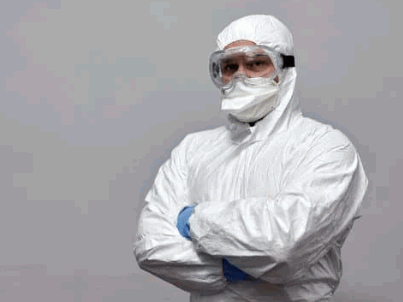
How Do I Pressure Wash My Patio?
- To pressure wash your patio effectively, start by preparing the area, applying the appropriate cleaning solution, adjusting the pressure washer settings, and then initiating the pressure washing process.
- It is crucial to ensure that all furniture, plants, and other items are removed from the patio to avoid any damage during the pressure washing process. Protecting delicate surfaces or plants nearby is essential.
- Once the area is clear, mix the cleaning solution according to the manufacturer’s instructions and apply it generously to the surface of the patio. This step helps to loosen dirt and grime, making it easier to remove during the pressure washing. Adjust the nozzle on your pressure washer to the appropriate setting depending on the surface material of your patio. Using too high a pressure can cause damage, while too low might not effectively clean the surface.
Prepare The Area
Before pressure washing, ensure the patio area is cleared of debris, furniture, and other items, and apply pre-treatment solutions for stubborn stains or grime removal.
Once the patio is cleared, begin by sweeping away loose dirt and debris with a broom or leaf blower to create a clean surface for the cleaning process. It’s essential to also check for any cracks or damaged areas that may require repair before proceeding with pressure washing.
Choosing the right pre-treatment solution is crucial. Depending on the type of stains or grime present, you can opt for gentle household cleaners, eco-friendly solutions, or specialised patio cleaning products to effectively break down tough buildup.
Investing in the correct equipment is key to achieving optimal results. A high-quality pressure washer with the appropriate settings can make the cleaning task more efficient and thorough, while using the wrong tools may lead to damage or ineffective cleaning.
Apply Cleaning Solution
Once the area is prepared, apply the chosen cleaning solution evenly across the patio surface, focusing on areas with visible stains or grime buildup for thorough cleaning.
To ensure a successful cleaning process, start by selecting a suitable cleaning solution based on the surface material and the type of stains present on the patio. Different surfaces such as concrete, stone, or wood may require specific cleaners to avoid damage. When applying the solution, make sure to use a sprayer or a mop to achieve even distribution, as this is crucial for consistent and effective cleaning results. For areas with concentrated dirt or tough stains, consider pre-treating them with a stronger solution or allowing the cleaner to sit for a few minutes before scrubbing. Expert patio cleaning advice often recommends working in smaller sections to manage the application and cleaning process efficiently.

Adjust Pressure Washer Settings
Before starting the pressure washing, adjust the pressure washer settings according to the patio material and cleaning requirements to achieve optimal results without causing damage.
Adjusting pressure washer settings is crucial when it comes to effectively cleaning different surfaces without risking any harm.
A common mistake many make is using too much pressure, which can lead to irreversible damage. For example, delicate concrete patios require a lower setting compared to tougher stone surfaces. By setting the pressure appropriately, you not only ensure a thorough cleaning process but also protect the integrity of your patio. This careful approach helps in preserving the longevity and aesthetics of your outdoor space.
Begin Pressure Washing
Start pressure washing by directing the nozzle at a 45-degree angle to the surface, maintaining a consistent distance to ensure thorough cleaning, considering safety precautions and the importance of precise cleaning techniques.
Before beginning the pressure washing process, it is crucial to inspect the area for any obstacles or fragile objects that could be damaged by the high-pressure water. Remove any furniture, plants, or valuable items from the vicinity to prevent accidental damage. Ensure proper ventilation in the area to avoid inhaling fumes or getting chemicals on the skin or clothing.
When cleaning your patio, take note of any potential hazards such as slippery surfaces or loose debris that could cause accidents. Sweep the area beforehand to remove loose dirt and debris, reducing the risk of slipping during the cleaning process.
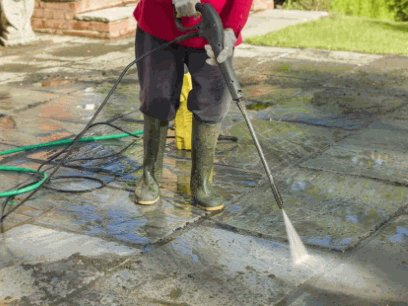
What Are The Safety Precautions For Pressure Washing?
When pressure washing, it is crucial to wear protective gear, exercise caution around electrical outlets, and be mindful of surrounding surfaces and objects to prevent accidents and surface damage.
It is recommended to inspect the pressure washer for any leaks or damage before each use. Proper cleaning techniques, such as starting from a distance and gradually moving closer to the surface, can help avoid damage. Expert advice suggests using the appropriate nozzle for the specific cleaning task at hand to maximise efficiency and safety. It’s important to never point the pressure washer at oneself or others and to always operate the equipment in a well-ventilated area to avoid inhalation of harmful fumes.
Wear Protective Gear
Protective gear such as gloves, goggles, and boots should be worn to shield against potential injuries and minimise the risk of pressure washer damage during cleaning activities.
Wearing a protective apron and a face shield can offer further protection from high-pressure water sprays and chemical splashes. It is important to ensure that all protective gear fits properly and is in good condition before starting any pressure washing task.
- Not using the necessary protective equipment can lead to severe injuries such as cuts, burns, and eye damage.
- One must remember that even seemingly harmless substances like mildew or algae can pose health risks when exposed to high pressure.
- Ensuring personal safety while handling a pressure washer means adhering to patio cleaning best practices and following proper patio cleaning safety protocols to prevent accidents or mishaps.
Use Caution Around Electrical Outlets
Exercise caution when pressure washing near electrical outlets to prevent electrical hazards, ensuring safety measures are in place to avoid accidents and damage.
It is vital to be mindful of the risks posed by water and electricity coming into contact, which can lead to severe injuries or even fatalities.
One of the crucial safety guidelines is to keep all electrical outlets covered and away from water sources.
Patio cleaning holds the utmost importance to enhance the aesthetics and longevity of outdoor spaces, but always prioritize safety in all cleaning procedures.
Be Mindful Of Surfaces And Objects
When pressure washing, pay attention to surrounding surfaces and objects to avoid accidental damage, using appropriate techniques and tools to ensure thorough cleaning without causing harm.
Be mindful of nearby walls, windows, and delicate plants that may be affected by the high-powered water stream. Consider using a surface cleaner attachment for more even and controlled cleaning on surfaces like concrete, stone, and decking.
To maintain a safe cleaning environment, wear protective gear such as gloves and goggles. Keep a safe distance from the area being cleaned, especially when using high pressure. Move systematically and consistently to achieve the best results with minimal risk to the patio cleaning surface.
When Should I Hire A Professional For Pressure Washing?
Consider hiring a professional for pressure washing if you lack the necessary equipment or experience, or have a large or complex patio that requires specialised cleaning techniques.
Professional pressure washing services can be invaluable in handling challenging outdoor cleaning tasks, especially those involving intricate surfaces or stubborn dirt buildup. Without the proper tools and know-how, attempting to clean a vast or intricate patio on your own may result in incomplete or ineffective results.
Expert assistance can ensure that your patio receives thorough and pristine cleaning, enhancing its appearance and longevity. Reputable professionals bring not only the right equipment but also the expertise to efficiently tackle even the toughest stains, mould, or grime.
If You Don’t Have The Proper Equipment
If you lack the necessary equipment such as a pressure washer or cleaning products for efficient patio cleaning, it is advisable to hire a professional who has the right tools for the job.
Proper patio maintenance requires specific tools like a pressure washer to effectively remove deep-seated dirt and grime. Without the correct equipment, the cleaning process may be ineffective, leading to unsatisfactory results. Seeking assistance from a professional ensures access to specialised tools and expertise, increasing the chance of achieving a thorough cleaning. Professionals are equipped to handle common patio cleanings challenges such as stubborn stains or mould growth. By investing in professional services, you can maintain the integrity of your patio while ensuring it remains clean and inviting.
If You Don’t Have Experience
When you lack experience in pressure washing techniques or are unsure about suitable cleaning methods, it is wise to consult a patio cleaning expert for valuable advice and guidance.
Professionals in the field of patio cleaning possess a wealth of knowledge that can save you time, effort, and even money in the long run. By seeking their expertise, you can ensure that your patio surfaces receive the proper care and maintenance they require to look pristine and last longer.
Experienced professionals can not only recommend the most effective patio cleaning solutions but also demonstrate the best practices for achieving spotless results without damaging the surface. This hands-on learning experience is invaluable for those looking to improve their own cleaning techniques and enhance the overall appeal of their outdoor spaces.
If You Have A Large Or Complicated Patio
For large or intricately designed patios that require specialised cleaning methods, consider hiring a professional with expertise in handling complex cleaning tasks effectively.
Professional patio cleaning services can tackle the challenges of cleaning large or intricate outdoor spaces that have accumulated dirt, stains, and debris over time. Expert cleaners have the tools, knowledge, and experience to ensure a thorough and effective cleaning process, restoring the beauty and functionality of your patio.
When selecting a professional cleaning service for your patio, it is crucial to verify their experience in dealing with different types of surfaces and materials commonly found on patios. Expert cleaners should be adept at managing various cleaning solutions, delicate finishes, and intricate patterns without causing damage.
